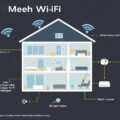In the age of home automation and smart devices, maintaining a robust and high-speed internet connection throughout your home has become essential. One effective method to enhance your network’s performance is by utilizing a dedicated backhaul. This article delves into the concept of dedicated backhaul, its benefits, and how it can streamline your network setup for optimal performance.
What is a Dedicated Backhaul?
Backhaul refers to the connection method used to transmit data between the main router and additional nodes in a mesh WiFi system. Unlike traditional routers which have a single point of broadcast, mesh systems utilize multiple access points that work collaboratively to extend WiFi coverage. A dedicated backhaul implies that there exists a specific communication channel reserved solely for the connectivity and communication among these mesh nodes, separate from the channel used to communicate with client devices.
Types of Backhaul: Wireless vs. Wired

Wireless Backhaul
Wireless backhaul systems, such as those that employ Dedicated Wireless Backhaul (DWB), ensure that communication between nodes does not interfere with the bandwidth available for client devices. This means that activities such as streaming, gaming, and video conferencing can be smoother and uninterrupted, as the backhaul connection operates on its own dedicated channel.
Wired Backhaul
In contrast, wired backhaul utilizes Ethernet cables to connect the nodes to the primary router. This method is often more stable and can provide better speeds, especially in environments with numerous connected devices. However, the installation process can be cumbersome, often requiring significant cabling and setup efforts.
Many users wonder if simply connecting some nodes with Ethernet while others remain wireless qualifies as backhaul. For optimal performance, it’s recommended that all nodes in a mesh system utilize wired connections if possible, creating a fully integrated backhaul experience.
Importance of Using a Dedicated Backhaul
-
Enhanced Performance: By segregating data transmission between nodes from other device traffic, systems with dedicated backhaul facilitate improved data transfer speeds. This results in a more responsive network ideal for high-demand scenarios like gaming or streaming 4K video.
-
Reduced Interference: Since the dedicated backhaul operates independently from client connections, it minimizes bandwidth competition. Consequently, devices can communicate more effectively, leading to fewer lags and better overall experience.
-
Ease of Setup: Most modern mesh systems with dedicated backhaul capabilities come with intuitive installation processes, often allowing automatic detection of backhaul channels without the need for intricate network configurations.
-
Cost-Effective Scaling: Home networks can gradually scale their systems, as adding new nodes typically does not compromise overall performance. Such expandability makes dedicated backhauls a future-proof solution for growing households with expanding network needs.
Choosing the Right Setup
When pondering a mesh network, consider models that explicitly support dedicated backhaul. These systems, such as those from ASUS and NETGEAR, offer advanced features that cater to both wired and wireless backhaul options.
It’s vital to analyze your specific needs, usage patterns, and home layout before making a decision. For larger homes, a dedicated backhaul can drastically enhance performance. Conversely, smaller spaces may find adequate service with less robust options.
Conclusion
Investing in a dedicated backhaul can markedly enhance your home network’s efficiency and reliability. As smart homes evolve and the demand for bandwidth continues to increase, implementing a dedicated backhaul system is an effective step towards a seamless internet experience. Whether through wired connections or optimized wireless configurations, this approach can unlock the full potential of your network, accommodating the needs of all connected devices in your home.



